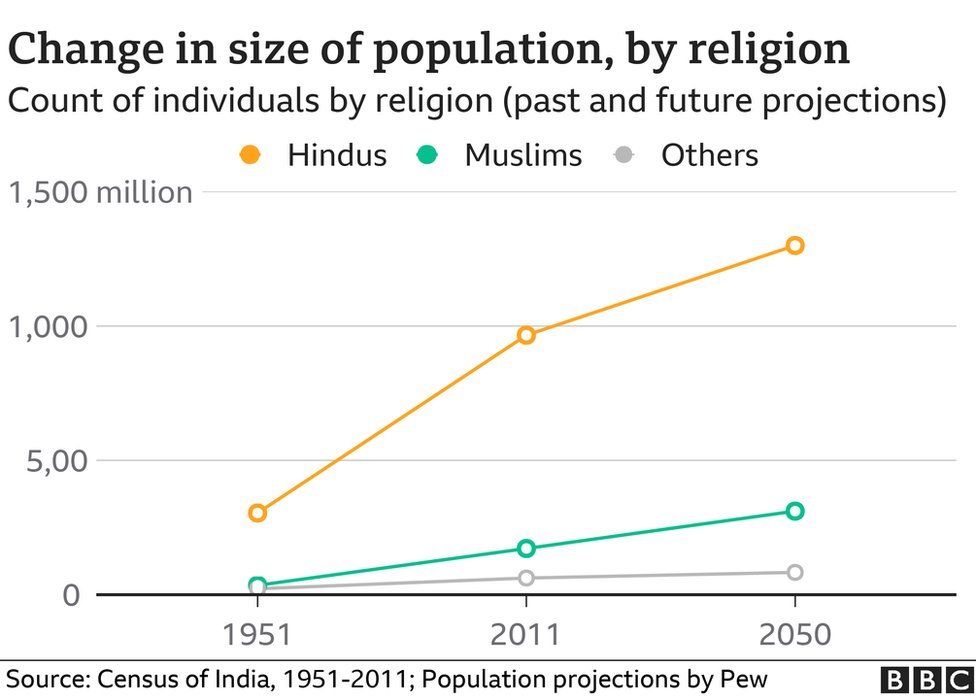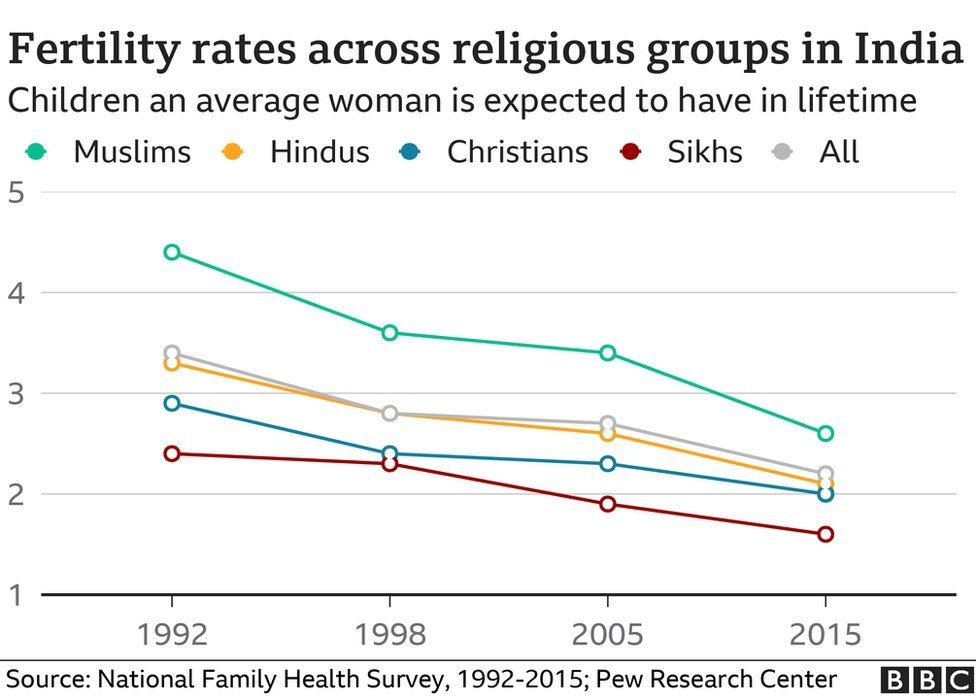
By Soutik Biswas
As a result there have been only “modest changes” in the religious make-up of the people since 1951.
The two largest groups, Hindus and Muslims, make up 94% of India’s 1.2 billion people.
Christians, Sikhs, Buddhists and Jains together make up the remaining 6% of the population.
Based on data available in India’s decennial census and the National Family Health Survey (NFHS), the Pew study examines how the country’s religious composition has changed, and the main reasons behind the changes.
India’s population has more than trebled following the 1947 division of a colonial state into Hindu-majority India and Muslim-majority Pakistan – from 361 million people in 1951, to more than 1.2 billion people in 2011. (Independent India held its first census in 1951, and the last one was conducted in 2011.)
During this period, every major religion in India saw its numbers rise, the study found.
The number of Hindus increased from 304 million to 966 million; Muslims grew from 35 million to 172 million; and the number of Indians who say they are Christian rose from 8 million to 28 million.
The religious make-up of Indians
- Hindus make up 79.8% of India’s 1.2 billion people in the 2011 census. 94% of the world’s Hindus live in India
- Muslims comprise 14.2% of Indians. India is home to one of the world’s largest Muslim populations, surpassed only by Indonesia
- Christians, Sikhs, Buddhists and Jains together make up 6% of the population
- Only about 30,000 Indians described themselves as atheists in 2011
- Around 8 million people said that they did not belong to any of the six largest groups
- There were 83 smaller religious groups and each had at least 100 adherents
- India gains roughly 1 million inhabitants every month, putting it on course to overtake China as the world’s most populous country by 2030
(Source: 2011 census, Pew Research Center)
Muslims still have the highest fertility rate (2.6 children per woman in 2015) among the major religious groups, followed by Hindus (2.1). Jains have the lowest fertility rate at 1.2.
The study says the general pattern is largely the same as it was in 1992, when Muslims had the highest fertility rate (4.4), followed by Hindus (3.3).
“But the gaps in childbearing between India’s religious groups are generally much smaller than they used to be,” the study said.

And the slowdown in population growth has been more pronounced among India’s minority groups who outpaced Hindus in earlier decades.
What is striking is a fertility decline of nearly two children per woman under 25 years in a single generation among Muslims, according to Stephanie Kramer, a senior Pew researcher specialising in religion.
As the number of children Indian women had declined from an average of 3.4 per woman in the early 1990s to 2.2 in 2015, the rate among Muslims fell even more steeply from 4.4 to 2.6.
Over a period of 60 years, the Muslim share of India’s population grew by 4%, while the Hindu share declined by about the same amount. The other groups held fairly steady.
Family sizes are influenced by a host of factors, making it “impossible to pinpoint exactly how much religious affiliation alone impacts fertility”, the study says. Unlike in many countries, the impact of migration or religious conversion on demographic change in India is “negligible”.
Fertility has been by far the “biggest driver” of the modest amount of religious change in India.
Population growth was driven also by the fact that groups with younger population have more women “entering their prime childbearing years and, as a result, tend to grow faster than the older populations”. As of 2020, the study says, Hindus have a median age of 29, compared with 24 for Muslims and 31 for Christians.

The other drivers of population growth in India include education levels of women (highly educated women often marry later and have their first child later than less educated women) and wealth (poorer women tend to have more children so that they can contribute to household work and incomes).
The findings are not entirely surprising because India’s overall fertility rate has been declining steeply in recent decades – an average Indian woman is expected to have 2.2 children in her lifetime.
That’s higher than rates in countries such as the US (1.6), but lower than India’s in 1992 (3.4) or 1950 (5.9).
One interesting finding of the study is that only a few Indians don’t claim membership of any religious group. Globally, “none” is the third most common religious affiliation – after Christian and Muslim.
“So it is interesting to see the unaffiliated are barely represented in such a large country,” Ms Kramer says.
Also, several religious groups are concentrated in India to an “unusual extent”: 94% of all Hindus live there, as well as the vast majority of all Jains and over 90% of Sikhs. Most Sikhs in the world live in just one Indian state – Punjab.
Compare this to China, which has a larger population, houses about half of the world’s Buddhists and most unaffiliated people, but “nothing like 90% of any major religious group”.
“There’s really no country with a similar religious landscape to India,” says Ms Kramer.
This story first appeared on bbc.com

